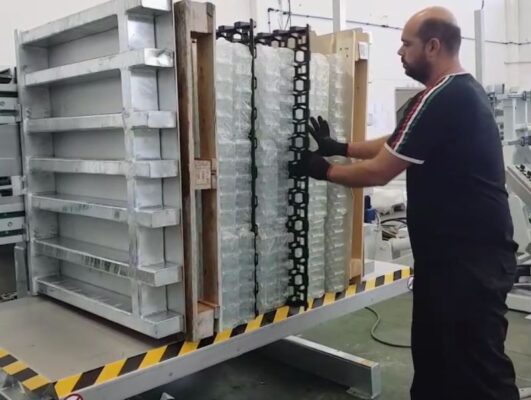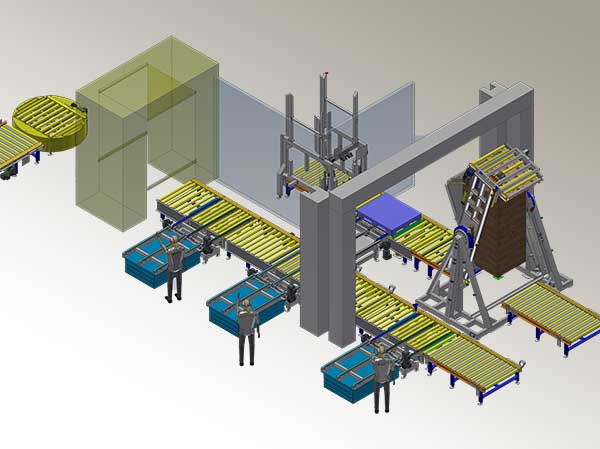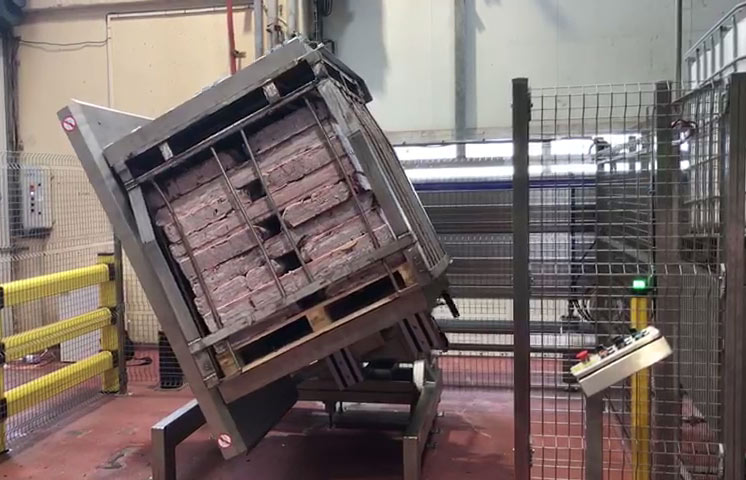Are you working in a cold room warehouse facility? It can be difficult to manage frozen products on pallets that have to enter and leave the cold rooms. Well… you are in the right spot 🙂 Top Industries offers multiple machines, discover our new pallet inverter for frozen foods!
You might consider selecting a few modules, pallet racks, or also conveyors. Many more items may also come to your mind particularly if you are among those who are well-conversant with this field.
Although there can be a little inconsistency among different applications of material handling, however, a few products may need a certain unique approach.
Your usage of a product may tend to vary in different kinds of environments so you have to pay close attention to the design of your warehouse.
To design a cold room warehouse within an existing warehouse design needs a particularly unique approach especially if you are planning to maximize your usable space and also maintain overall efficiency then it is necessary to understand the proper standards of material handling.
Characteristics of your cold room warehouses that need to be considered:
- The cold room warehouse storage temperature
- Consistency of airflow
- Impact on equipment
Nowadays, there is an increasing trend among the consumers who are taking interest in different product selections, healthy foods, and more convenient meal preparation, and therefore most of the food manufacturers in meat, dairy, and baked goods are supplying a widening array of new SKUs (stock keeping unit) in both chilled and frozen formats.
There is an ever-increasing demand on the facility of cold storage, and with older facilities, it may not be too easy to automate them.
Positions, where there is a requirement for working in sub-zero temperatures, are especially difficult to fill in a place where the labor market is too tight.
However, with the help of automation, which is tightly integrated with building design and also supported by advanced management practices, it is possible to resolve labor issues and improved efficiency can be achieved.
The following few best practices can be the key for your cold room warehouse


Begin with the cold room warehouse automation system
Because the strategy of automation is integral to your building design, so, wherever possible you must go for the automation system before your building is designed.
This will help your building designer to leverage the capabilities of the system fully to achieve greater efficiencies.
Among the few most popular systems used for cold storage automation are:
- Stacker cranes
- Robotic pallet shuttles.
Out of this, stacker crane systems are a cost-effective and also reliable approach to developing automated cold room warehouse and retrieval, particularly where the highest density is not required throughout.
Robotic pallet shuttles can deliver many of the similar benefits of stacker cranes and also support higher density and throughput.
Think big
Any traditional warehouse which has got 40-foot ceiling heights may not be conducive to efficient refrigeration as the square footage of the roof will introduce heat from solar energy, and increase the load on your refrigeration system.


If the facility needed is a cold room warehouse, then also it will have a heated floor, which will further add to the heat load.
These issues can be resolved by designing the buildings. You will need to look for floor plans that can help in increasing the storage capacity, while reducing the area needed for the same.
That needs a building with taller warehouses, supported by automation systems that can offer vertical storage as mentioned above.
By increasing the building height, you can allow the building designer to obtain a footprint nearly 33% of that of a conventional facility, and save the life of your facility.
Carton handling must not be overlooked
In addition to changing and inverting the pellets, classic and cold room warehouses can also automate the ground level processes like carton handling in order to improve the overall operations. It will also help in reducing the manpower costs.
Some of the warehouses increase their efficiency with the help of robotic systems to pick the crates or cases.
This type of automations can be come with the combination of the following:
- Light-goods shuttle systems
- Conveyors
- High-performance palletizing as well as de-palletizing robotic technology
The system can always be configured for small, mid-size, and also large distribution centers that can handle up to 500,000 cases a day.

The technology should be resilient to cold temperature
You will need to ensure that each and every component of the cold room warehouse operational system has high resistance to freezing or extremely low temperatures. It will help in reducing the repair and maintenance costs in the long run. As already mentioned above, remote monitoring of these cold-storage facilities is critical.
The technology should be resilient to cold temperature
You will need to ensure that each and every component of the warehouse operational system has high-resistance to freezing or extremely low temperatures. It will help in reducing the repair and maintenance costs in the long run. As already mentioned above, remote monitoring of these cold-storage facilities is critical.
Reducing the cost of energy during high-demand periods reduces the impact of surge pricing and also can drive down costs. Of course, the challenge in costs will be highest during high ambient-temperature periods when the thermal load on your cold room warehouse refrigeration system will be at its highest.


The key will be to adopt highly developed control algorithms and a few sensors that can enable smart energy management where cold environments are overcooled when the demand is low, such as overnight, creating a certain thermal buffer that can minimize cooling requirements during peak periods.
This rising demand for various chilled and frozen foods worldwide has made refrigerated warehousing a highly expanding sector for distribution.
A study was published by the IARW (International Association of Refrigerated Warehouses) in the IARW Global Cold Storage Capacity Report in 2016 that shows 210 million cubic feet of refrigerated space was added to various North American warehouses from 2014 to 2016, which represents a 2.3% annualized growth rate.
Therefore, the cold room warehouse demand is growing but the labor for manning these facilities is not.
So, automation is the only viable option and the best approach to automation will be the one that integrates automation, building design, and operating practices in ways that optimize total throughput, labor, and also energy management.
Traditional conveyor systems are now out of question in a cold room warehouse facility, because They may degrade faster and may lead to productivity concerns.
